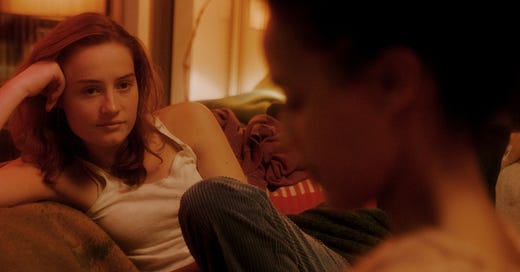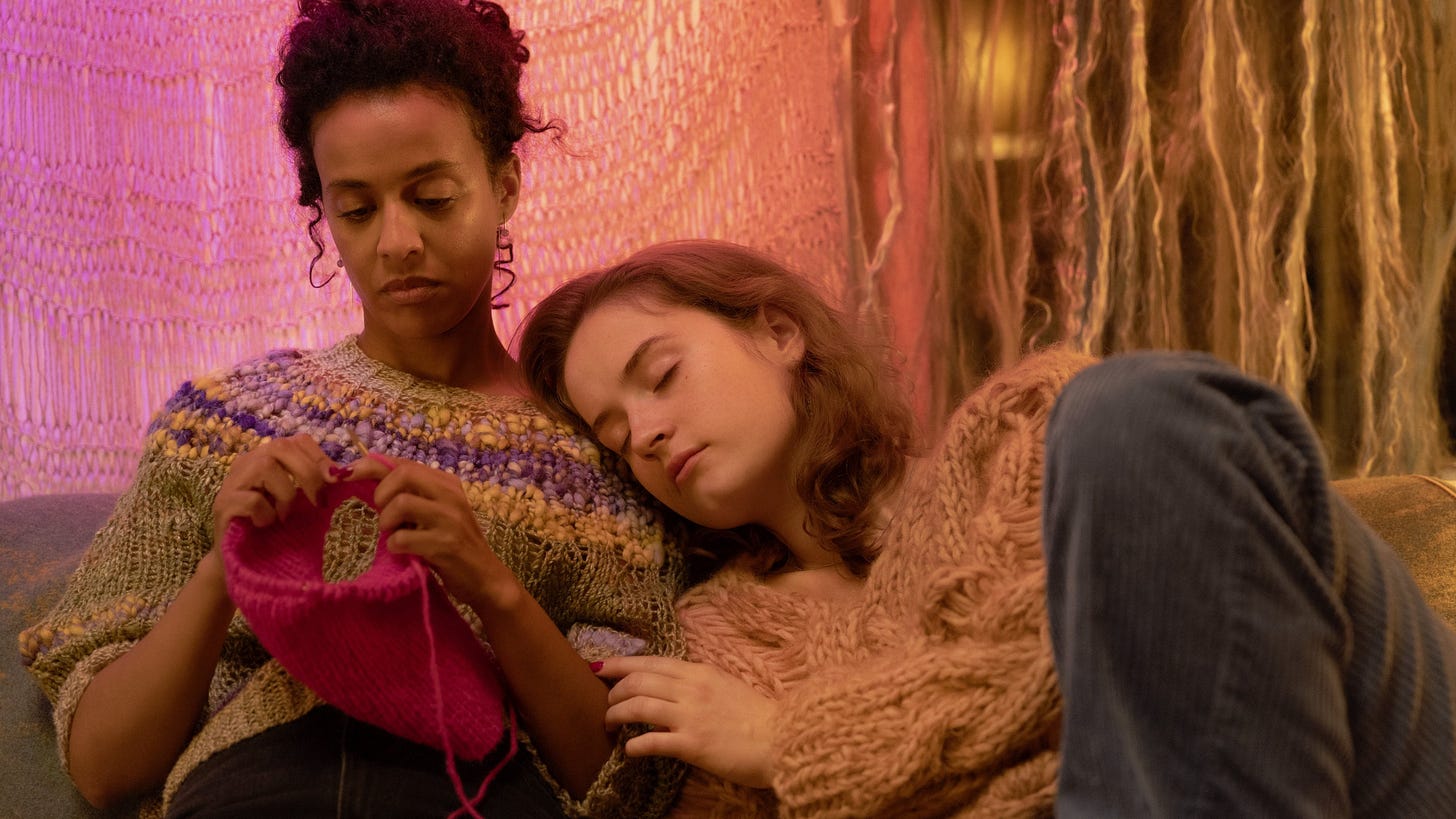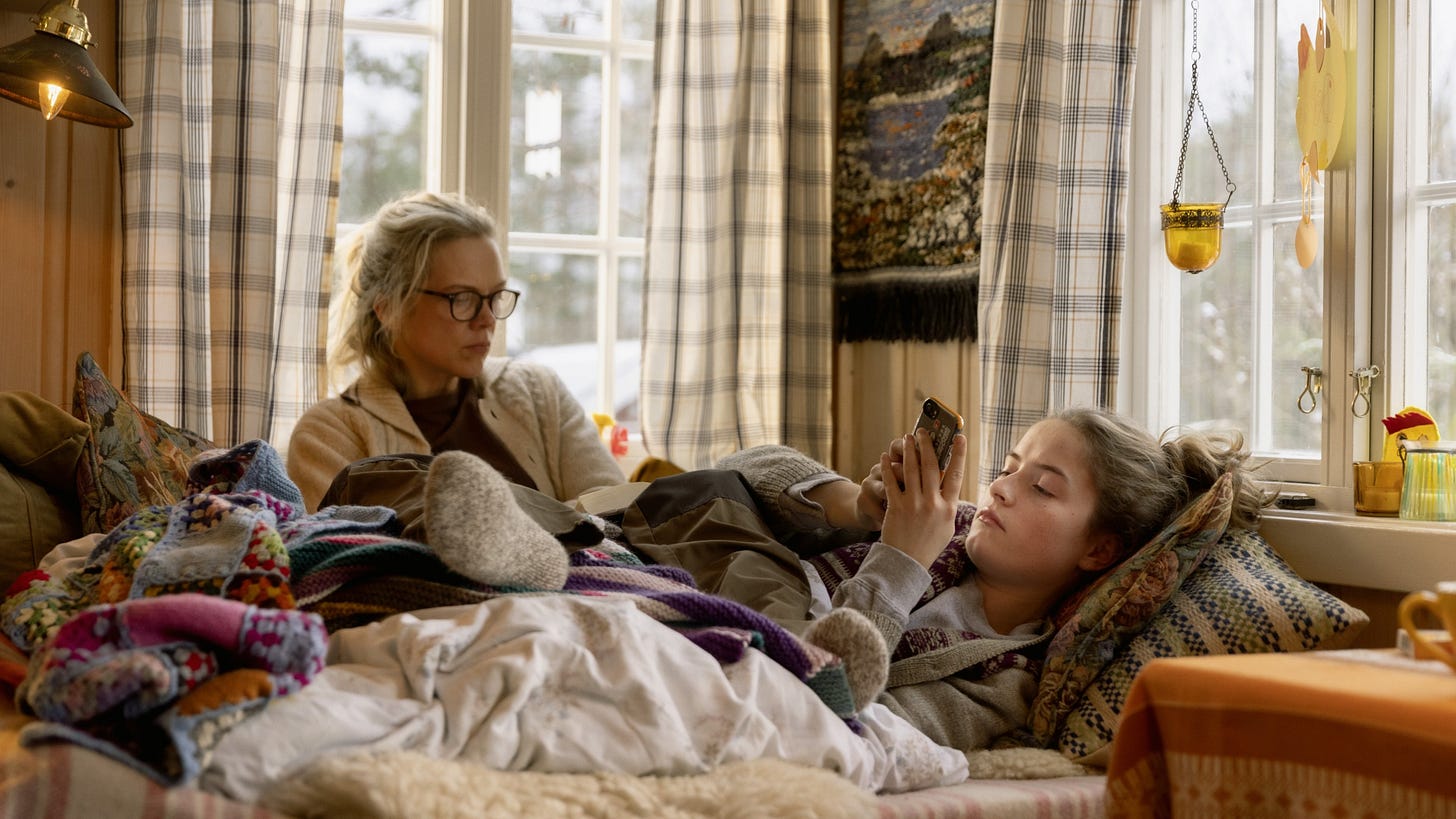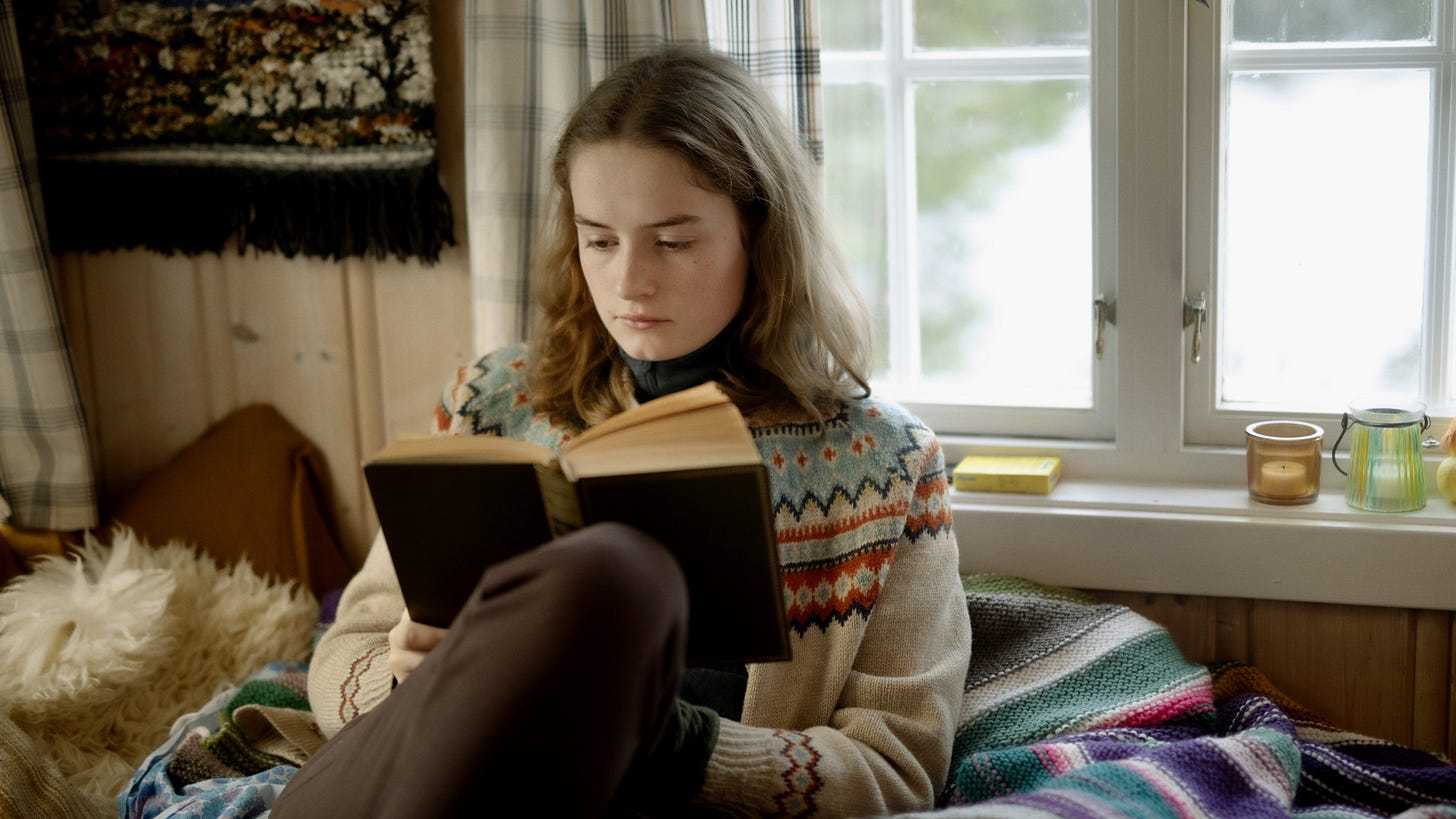Crítica em português
A terceira parte da trilogia iniciada com Sex (2024), premiado no Festival de Berlim, e Love (2024), exibido no Festival de Veneza, este Dreams reflete sobre o relacionamento platônico entre a adolescente sonhadora Johanne (Ella Øverbye) e a sua professora da escola, Johanna (Selome Emnetu). Uma idealização que muitos já experimentaram na adolescência, embora poucos tenham tido a coragem de materializá-la honestamente, a princípio apenas para consumo próprio, após como forma de confidência com avó e mãe, para, quem sabe, transformar a experiência em literatura. É até surpreendente, a meu ver, que tenha sido um homem, Dag Johan Haugerud, o roteirista e diretor de um filme que parece enxergar com tamanha doçura e sensibilidade o mundo pelos olhos de Johanne, mas não somente dela, também das mulheres da família (Ane Dahl Torp e Anne Marit Jacobsen, a mãe e a avó, respectivamente).
Dreams é o bem humorado retrato do amadurecimento, dos conflitos geracionais e da importância da literatura, ou da arte de modo geral, como um meio de compreender, elaborar e processar as emoções, sensações e o gosto amargo do primeiro amor não concretizado. Como narrativa que explora a expressividade literária, é natural que a direção recorra à narração in off de Johanne. Um diálogo sobreposto nas imagens da adolescente, enquanto encara o mundo da janela do quarto ou se conforta no olhar - que olhar, viu? - da sua professora. Um olhar a que atribui reciprocidade, onde só há inocência. A narração é tão rebuscada quanto uma adolescente é capaz de produzir, apesar de fascinar a sensibilidade e mesmo a cadência da escrita, como se a falta de repertório fosse substituída por um talento nato, herdado da avó, também escritora.
A relação com a mãe e a avó, e entre estas duas é também marcante. Johanne crê na opinião da avó, que enxerga o conto a princípio pelo potencial comercial que possui, elogiando o que denomina ser um dispositivo literário ambíguo. Para a mãe, pode se tratar de uma forma de abuso. Ao menos na primeira leitura, já que o poder literário logo é revelador de uma narrativa de empoderamento feminino - um discurso que é associado à frente com o clássico Flashdance. A propósito, o relacionamento aberto e sincero entre gerações de mulheres faz com que a ação seja deslocada da filha, apenas para acompanhar mãe e avó realizando uma trilha na floresta. Em vez de quebrar o ritmo interno da narrativa, esses momentos reforçam o monopólio feminino - quando homens aparecem, ou é brevemente na sala de aula, ou no terceiro ato, revelando qual é o verdadeiro dispositivo de enquadramento do filme.
É uma história de amor que, na realidade, é sobre amor próprio, através do direito ao aprendizado com as paixões e frustrações. É também uma história de amor à escrita e à forma como esta pode tocar e transformar quem a lê - o sonho de quem deposita, no papel ou na internet, palavras é esse -, e empoderar quem escreve. Tudo isso com um bom humor simultaneamente formal, como quando a trilha sonora é interrompida de forma literal pela mãe, quanto está presente no conteúdo do roteiro. E se mencionei o elemento formal, Dreams tem a rara beleza da infusão que parece até desabrochar na xícara de chá do mesmo jeito que a flor no canteiro, e da neblina recobrindo a escada que parece levar quem sobe seus degraus em direção ao céu, às nuvens de Johanne.
Além do mais, a sensação é de que cada composição, por menor que seja, tenha sido pensada com cuidado, do mesmo jeito que Johanne reflete sobre as palavras que pôs no conto. A direção de fotografia de Cecilie Semec emoldura, embeleza, complexifica e torna misteriosa imagens que poderiam ser triviais. Quando Johanna é visitada por uma outra mulher, a ciumenta Johanne é literalmente recortada pela divisória entre a sala e a cozinha. O foco é também explorado para revelar objetivamente a perspectiva da protagonista, que é interpretada com candura e humanidade por Ella Øverbye, até certa irreverência, quando lamenta o fato de não saber tricotar. Uma piada cuja punch line vem mais à frente, quando Johanna compara o talento de Johanne na escrita e no tricô.
E o tricô, que é uma arte tão associada ao feminino, desempenha um papel poético, no livro que inspira Johanne a escrever e idealizar o amor que não pode ter, até mesmo no toque fortuito durante o laço feito no pescoço de outra pessoa. O cachecol que protege do frio - portanto que convida ao calor, e que forma mais bela de calor existe que não o amor? - é também o que une mulheres, que jamais poderiam ser unidas de outra forma - afinal de contas, uma é menor de idade. A minha sensação é de que cada momento de Dreams tenha sido um movimento de mão com a agulha para produzir uma obra de beleza universal e genuína.
Crítica originalmente escrita durante a cobertura do Festival de Berlim.
Dreams estreia quinta-feira (26) nos cinemas brasileiros com distribuição da Imovision.
English review
The third part of the trilogy that began with Sex (2024), which won an award at the Berlin Film Festival, and Love (2024), which was shown at the Venice Film Festival, this Dreams film reflects on the platonic relationship between the dreamy teenager Johanne (Ella Øverbye) and her school teacher, Johanna (Selome Emnetu). This is an idealization that many have experienced in their adolescence, although few have had the courage to materialize it honestly, at first just for their own consumption, then as a way of confiding in their grandmother and mother, to, who knows, transform the experience into literature. It is even surprising, in my opinion, that it was a man, Dag Johan Haugerud, who wrote and directed a film that seems to see the world with such sweetness and sensitivity through the eyes of Johanne, but not only hers, but also of the women in the family (Ane Dahl Torp and Anne Marit Jacobsen, her mother and grandmother, respectively).
Dreams is a humorous portrait of growing up, generational conflicts and the importance of literature, or art in general, as a means of understanding, elaborating and processing emotions, sensations and the bitter taste of first unrealized love. As a narrative that explores literary expressiveness, it is natural that the director would use Johanne's voice-over narration. A dialogue superimposed on the images of the teenager, as she looks at the world from her bedroom window or finds comfort in the gaze - what a gaze, see? - of her teacher. A gaze to which she attributes reciprocity, where there is only innocence. The narration is as elaborate as a teenager is capable of producing, despite the sensitivity and even the cadence of the writing being fascinating, as if the lack of repertoire were replaced by an innate talent, inherited from her grandmother, also a writer.
The relationship with her mother and grandmother, and between the two of them, is also striking. Johanne believes in her grandmother's opinion, who initially sees the story for its commercial potential, praising what she calls an ambiguous literary device. For the mother, this could be a form of abuse. At least on first reading, since the literary power soon reveals a narrative of female empowerment - a discourse that is associated with the classic Flashdance. Incidentally, the open and sincere relationship between generations of women causes the action to shift from the daughter, only to follow the mother and grandmother on a trail in the forest. Instead of breaking the internal rhythm of the narrative, these moments reinforce the female monopoly - when men appear, it is either briefly in the classroom, or in the third act, revealing what the film's true framing device is.
It is a love story that, in reality, is about self-love, through the right to learn from passions and frustrations. It is also a love story for writing and the way it can touch and transform those who read it - the dream of those who deposit words on paper or on the internet is this - and empower those who write. All this with a good humor that is simultaneously formal, as when the soundtrack is literally interrupted by the mother, while it is present in the content of the script. And if I mentioned the formal element, Dreams has the rare beauty of the infusion that seems to bloom in the teacup in the same way as the flower in the flowerbed, and of the mist covering the staircase that seems to lead those who climb its steps towards the sky, towards Johanne's clouds.
Furthermore, the feeling is that each composition, no matter how small, has been carefully thought out, in the same way that Johanne reflects on the words she put in the story. Cecilie Semec's cinematography frames, embellishes, complexifies and makes mysterious images that could be trivial. When Johanna is visited by another woman, the jealous Johanne is literally cut out by the partition between the living room and the kitchen. The focus is also explored to objectively reveal the perspective of the protagonist, who is played with candor and humanity by Ella Øverbye, even to a certain degree of irreverence, when she laments the fact that she doesn't know how to knit. A joke whose punch line comes later, when Johanna compares Johanne's talent for writing and knitting.
And knitting, which is an art so associated with the feminine, plays a poetic role in the book that inspires Johanne to write and idealize the love she cannot have, even in the fortuitous touch during the bow tied around another person's neck. The scarf that protects from the cold - and therefore invites warmth, and what more beautiful form of warmth is there than love? - is also what unites women, who could never be united in any other way - after all, one is a minor. My feeling is that each moment of Dreams was a movement of the hand with the needle to produce a work of universal and genuine beauty.
Ficha Técnica
Título original: Drømmer
Direção/Roteiro: Dag Johan Haugerud
Direção de fotografia: Cecilie Semec
Música: Anna Berg
Figurino: Ida Toft
Montagem: Jens Christian Fodstad
Elenco: Ane Dahl Torp, Ella Øverbye, Selome Emnetu, Anne Marit Jacobsen








